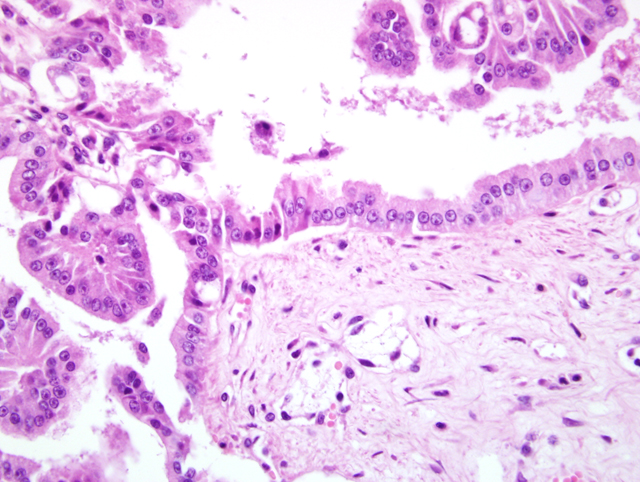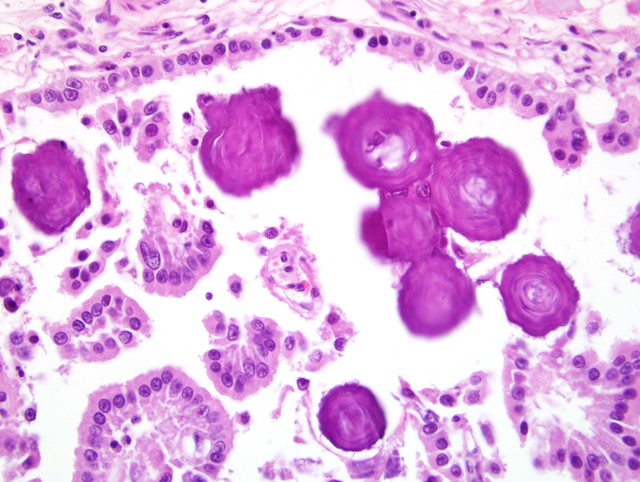Signalment:
Gross Description:
Histopathologic Description:
Morphologic Diagnosis:
Lab Results:
White blood cells count: 67 x 103 cells/mL (leucocytosis)
Red blood cells count: 2,3 x 106 cells/mL (anemia)
Hematocrit : 18%
MCH: 63 g/L
Reticulocyte count : 50 %
Condition:
Contributor Comment:
The fourth ventricle is the most common site for these tumors in man and dog. In our case, a primary mass was detected microscopically in the choroid plexus of the fourth ventricle. No significant lesion was detected at post mortem examination so the possibility of metastasis of another tumoral process was ruled out. The spinal cord tumor was multiple without embolus so the hypothesis of a meningeal carcinomatosis due to diffusion of the neoplastic cells through cerebrospinal pathways is highly probable. Concerning immunohistochemistry, it is reported that Pankeratin and CK AE1 positivity is observed in choroid plexus carcinomas with marked cell anaplasia, whereas CK AE3 is expressed by well-differentiated neoplastic cells.1 Vimentin positivity is observed in a large number of neoplastic cells. EMA and S-100 give negative results in all cases of choroid plexus carcinoma.
JPC Diagnosis:
Conference Comment:
Papillary ependymomas can be included in the differential diagnosis for choroid plexus tumors. On H&E, ependymomas contain pseudorosettes, occasionally true rosettes with cilia, and have a glial rather than a fibrovascular core.2,3 Immunohistochemistry may be necessary to differentiate the two.
Table adapted from Ribas et al.4 and Koestner et al.2
| Immunohistochemical stain | Ependymoma (Papillary) | Choroid plexus tumor |
| Cytokeratin | Positive | Positive |
| GFAP (glial fibrillary acidic protein) | Positive | Usually negative, but rarely positive |
By immunohistochemistry performed at the AFIP, neoplastic epithelial cells in this tumor had positive cytoplasmic immunoreactivity to cytokeratin and GFAP. While most reported cases of canine choroid plexus tumor are negative for GFAP, at least one case in the literature was positive for GFAP.1 GFAP positivity of some canine choroid plexus tumors is not surprising based on their histogenesis and the findings in human choroid plexus tumors. Human choroid plexus tumors are often positive for both epithelial markers and glial markers reflecting their hybrid nature. Ependymomas should be widely positive for GFAP and are generally negative for cytokeratin.5
References:
2. Koestner A, Higgins RJ: Tumors of the nervous system. In: Tumors in Domestic Animals, ed. Meuten DJ, 4th ed., pp. 709-712. Blackwell Publishing, Ames, IA, 2002
3. Koestner A, Bilzer T, Fatzer R, Schulman FY, Summers BA, Van Winkle TJ: Tumors of neuroepithelial tissue. In: WHO International Histological Classification of Tumors of the Nervous System of Domestic Animals. 2nd series, vol. V, pp. 17-24, Armed Forces Institute of Pathology and American Registry of Pathology, Washington, DC, 1999
4. Ribas JL, Mena H, Braund KG, Sesterhenn IA, Toivio-Kinnucan M: A histologic and immunocytochemical study of choroid plexus tumors of the dog. Vet Pathol 26:55-64, 1989
5. Summers BA, Cummings JF, de Lahunta A: Tumors of the central nervous system. In: Veterinary Neuropathology. pp. 351-401, Mosby, St. Louis, Missouri, 1995

